
Uncommons is a public sphere where a collective of Commons Builders explores Crypto Thoughts together.
Produced by ET Team | Cabin White Paper: Physical Node Network
Original author: Cabin DAO
Original Published: October 18th, 2022
Original link: https://creators.mirror.xyz/O6bTgNYk1eGBPRtAIM66v_OPWWI4nh8lmGCDT9aWylc
Translated by: Johnny J , Hana
Reviewers: Bigsong, CarolW
@ETH/Vitalik Translation Team GreenPill CN
Cabin White Paper: Physical Node Network
Cabin is building an "online city" for online creators. In a global network of physical places, our community is developing a shared culture , shared economy and shared governance . The MVP version of our Cyber City is a global co-living network for thoughtful people to create, co-live and co-maintain.
This document outlines the structure of our "city" and how it will develop over time:
- Defining our "Cyber City"
- Cabin Architecture: Physical Nodes, Residents and Contributors
- What we achieved (so far)
- how to get involved
- Apply to become a physical node of Cabin
- Cabin Resident Pass
- The development stage of Cabin "network"
- Phase 0: Launch of DAO (2021-2022)
- Phase 1: Sowing seeds for the "city" (2022-2023)
- Phase 2: Growing the "city" (2023-2025)
- Phase 3: Building an Urban Alliance (2025-2525)
Don't have time to read the full article? It doesn't matter. We have converted this white paper into PDF format so that you can download it and read it later. ☕️
Defining our "Cyber City"
Cities are places where sharing culture, sharing economy and sharing governance are highly concentrated. In the past, generating such densities required cities to be fixed in one place—however, cities also change as technology develops. The cities we live in today are designed around the movement of cars. We firmly believe that the cities of the future will be decentralized in physical space and highly organized in cyberspace.
Cabin is creating a global cyber city for online creators: knowledge workers who are flexible in location and make a living online. The community, culture, and economy of our "city" first took shape online, and then we started building physical centers in the real world (IRL). We are composed of independently owned and operated physical nodes, which usually have three typical characteristics:
- strong community
- fast internet
- close to nature
Our vision for the new city is a confluence of several trends:
- Economically: The gig economy and creator economy have grown and now extend to knowledge work
- Demographically: the growth of remote work and flexible workplace digital nomads
- Socially: Tokenized Digital Communities and URL's Pipeline to IRL
- Infrastructure: the emergence of emerging technology stacks such as satellite Internet, solar energy, self-driving cars, and modular housing
- On Governance: Emergence of Boom Cities, Network States, and Decentralized Autonomous Organizations
- On Natural Resources: Climate Change and a Renewed Enthusiasm for Local Regenerative Systems
These trends fit perfectly with what is described by Pace Layers and are consistent with the movement that arose around the Whole Earth Catalog 50 years ago.

The Whole Earth Catalog's mantra is "Access the Tools" and it makes these tools widely available to local "Back to the Land" communities. Steve Jobs called it " Google in paperback ." Going back to the Cabin, and for a less-than-descript but useful analogy; imagine if the Whole Earth Catalog used the following tools to develop its own economy:
- An overview table of people and places (or Token Curated Registry, or TCR for short)
- Physical Node development tools and resources centered around the Physical Node
- Tools for digital communication, coordination and governance
Cabin Architecture: Physical Nodes, Residents and Contributors
Cabin is a network of physical nodes owned and operated by its members. The network is designed as a DAO (Decentralized Autonomous Organization), self-governing through on-chain governance and protocols. Legally, the network is an unincorporated non-profit association (like a community association) made up of other independently operating organizations and members.
There are three types of roles in this network:
- Physical Nodes: Organizations that own and operate independent properties in the "network"
- Residents: people who spend time living and working in "physical nodes"
- Contributors: Service Providers Powering the Cabin Network and Economy
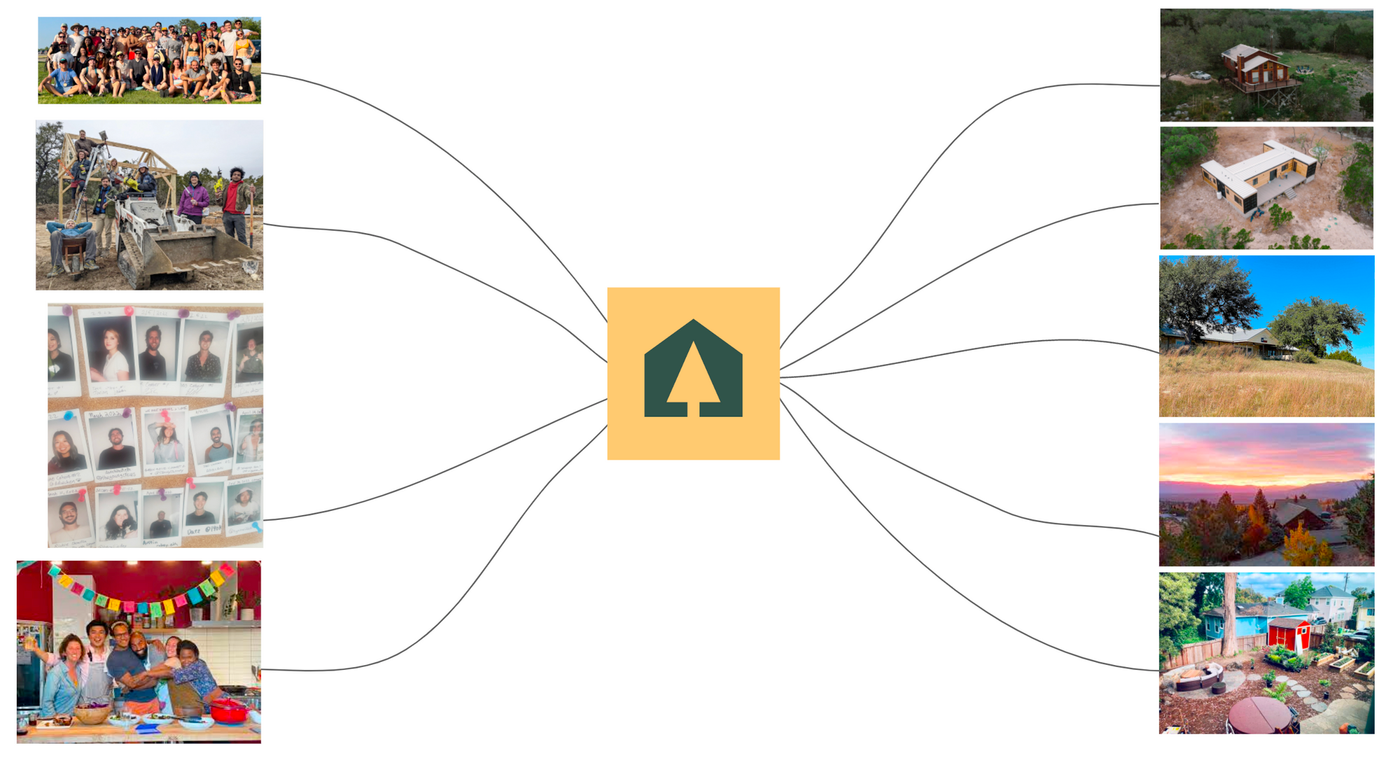
"Physical Node" is the core of Cabin "Cyber City". They are entities that are independently owned and operated by local communities. Physical nodes have "Guardians" who are catalysts on the journey of community building. They join Cabin to have access to the community and to use the tools developed by our "network". Physical nodes can engage in profit-making activities, but their motivation is not just money - it is the desire to build community and be part of a wider global community network.
"Residents" are the lifeblood of our "Cyber City," the community of people who live, work, and play at Cabin's physical nodes. Some residents come to the "Physical Node" for a short stay, while others stay for a long time. They join a Cabin to become part of a community and spend time in physical nodes with other residents of the community.
"Contributors" are service providers who help physical nodes find residents, help residents find physical nodes, and help physical nodes develop capabilities. They typically form small teams (called fellowships) that operate independently and are hired by our DAO to build network infrastructure and capacity. Cabin itself has no employees - it contracts contributors as needed to support the development of our "network".
What we achieved (so far)
Cabin started in 2021 as an accommodation project for independent online creators . We've since achieved an ambitious roadmap, planting the seeds for our "Cyber City":
physical node
- Developed "Physical Node No. 0" (Neighborhood Zero). During this phase, we worked on the project in three separate cabins located on 50 acres in Hill Country, Texas. At the heart of "Physical Node 0" is a custom-built 4-bedroom prefab container home designed for co-living, surrounded by amenities built by DAO members, like a sauna and fire pit pergola.
- Added two new physical nodes to the Cabin "network", Montaia Basecamp (located in the Sierra Nevada) and Radish (located in the California Bay Area).
- Started cooperative communication with dozens of potential future physical nodes, located in Washington, Puerto Rico, Nevada, Bangalore, Colorado, Portugal, and Costa Rica.
- Developed a framework for the Token Governance Registry to better form the basis of our Network.
Projects and Activities
- We continue to run numerous retreats and residency programs for DAO teams and leaders from across the ecosystem. Dozens of DAOs have visited Physical Node 0 for projects and team retreats. People who live in Cabin have launched many projects, including ConstitutionDAO, $DOG and Station.
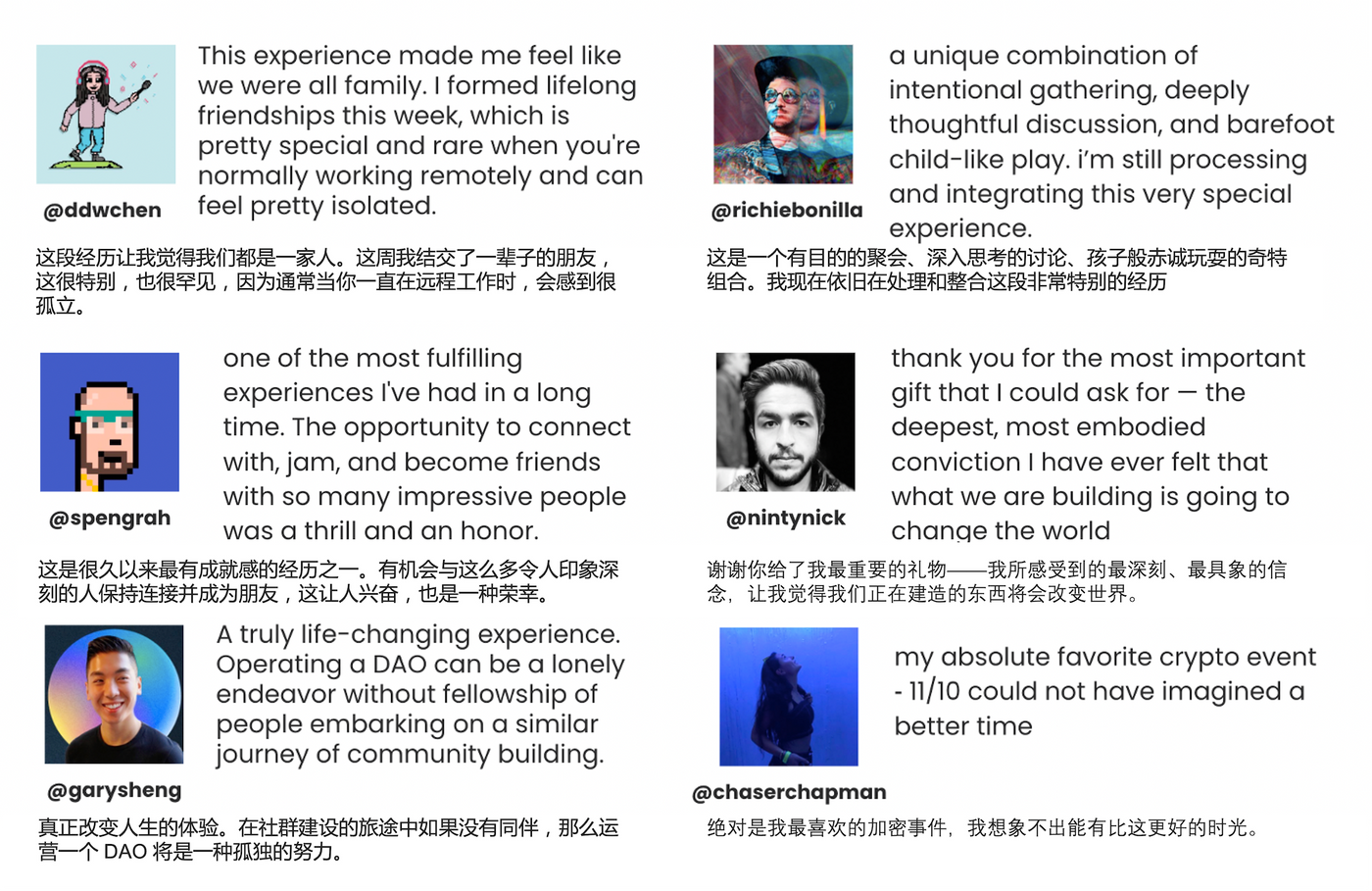
- Cabin supports physical nodes by running "Build Weeks" events - during "Build Weeks", DAO members help build the physical infrastructure of Cabin physical nodes. We gathered Cabin members to build a courtyard, gazebo, campfire and sauna. We are currently planning to expand the construction of the DAO in "Phys Node 0", including adding two cabins and a bathroom.

- We also convened conference-style gatherings that kickstarted larger groups, the first being "DAO Camp": a summer camp event for 60 outstanding leaders from the DAO ecosystem.

product development
- Launched the Cabin Pass physical card with public/private keys embedded in the chip
- Launched Pass Stamp NFT , our internal identity and reputation system
- Launched Blaze , a social aggregator for DAOs (split into Seed Club)
Media and Brand
- Grow our brand into one of the top social DAOs with high visibility
- 60+ articles published on creator.mirror.xyz , the top repository for sharing knowledge about DAOs
- Released 24 episodes of Campfire , a 5-star podcast for city builders
- Hosted hundreds of themed community events and online meetups
- Our twitter followers grew to 10,000 (100,000 impressions per month), our newsletter subscribers grew to 1,000, and our discord server grew to thousands of messages and voice minutes per week
- Featured in traditional top-tier publications as well as web3 publications

Apply to become a physical node of Cabin
If you are interested in building a physical node in Cabin's "Network City", you can start by applying or recommending someone to join the "Neighborhood Catalog" . The Physical Node Overview contains two types of checklists:
- Physical nodes (Neighborhoods): Approved to be part of the Cabin "Cyber City".
- Potential Nodes (Outposts): "Potential Nodes" who are interested in applying to become Cabin physical nodes.
The "Physical Node" is a semi-permanent place that hosts members of the Cabin community. A Cabin's city limits are defined by the Physical Node Overview, where Cabin members manage those physical locations that are part of the Cabin's "city".
"Potential nodes" are those where the local physical nodes are started. They can be permanent locations, or one-off or temporary event centers for those interested in building out of Cabin's Cyber City. These venues are not curated or funded by Cabin, but we maintain an overview of them to facilitate collaboration and create connections between potential physical nodes.
"Physical Node Overview"
When you successfully join the Physics Node Overview, you have an entry that describes your place and the items you want to provide to the community. You can see an example from the Physics Node Overview here:
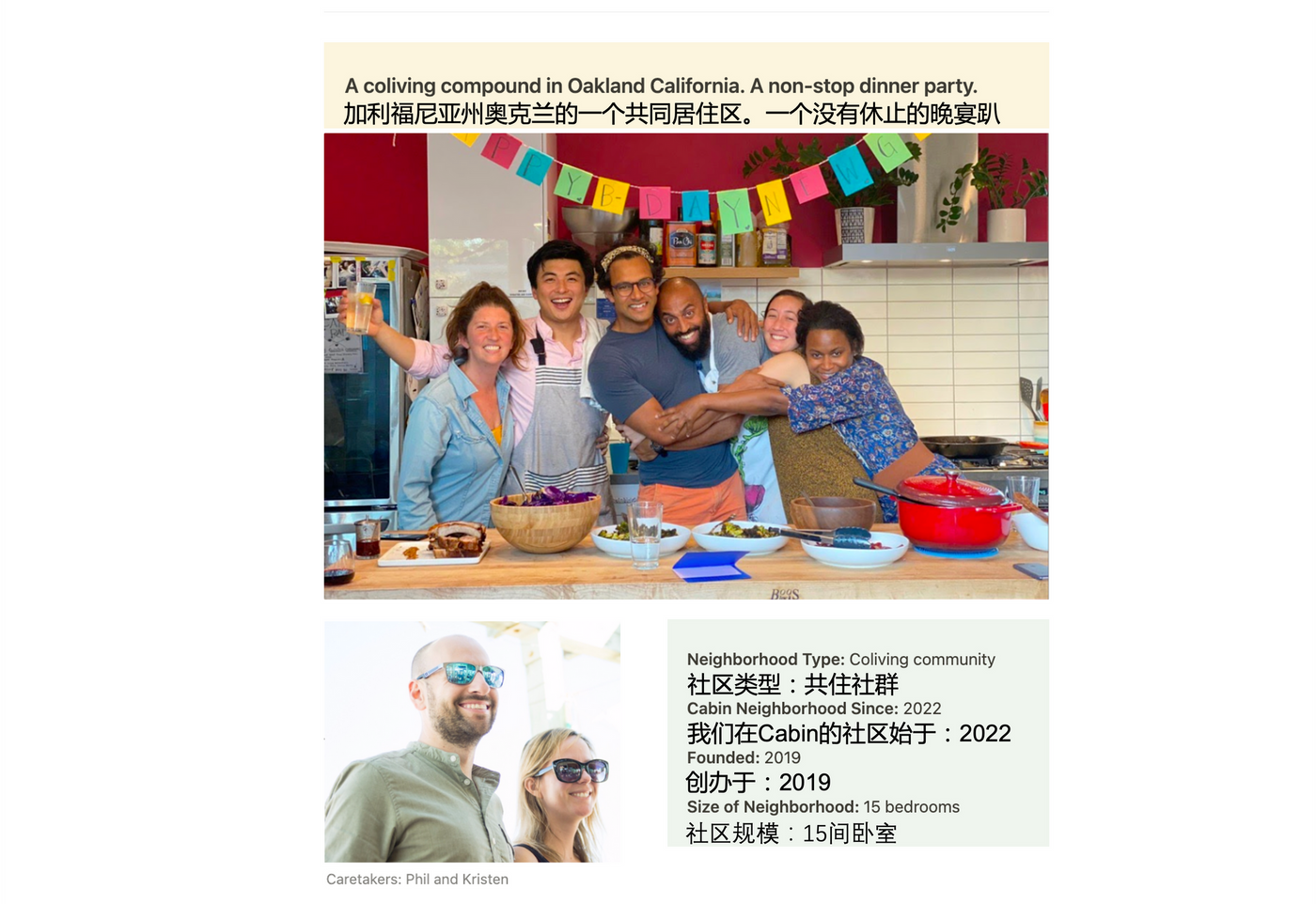
After joining the "Physical Node Overview", you can create various services to allow members of the Cabin community to participate in the projects, activities and accommodation plans of your physical node:
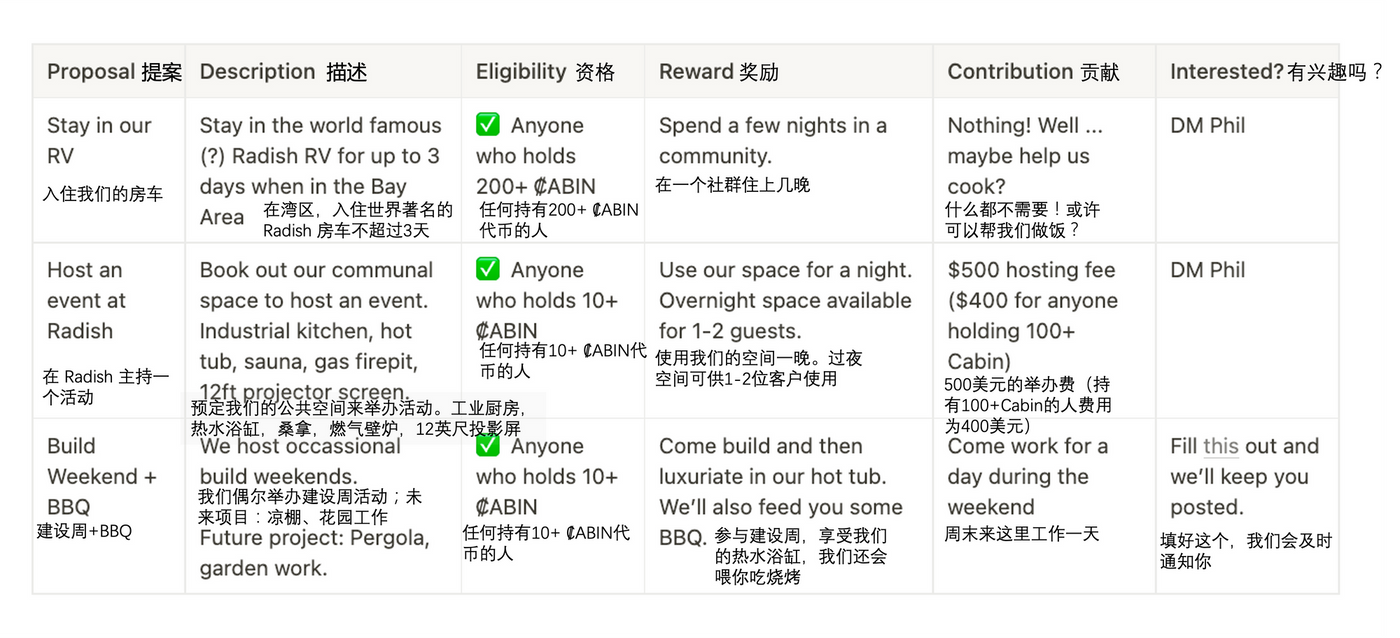
Join our Physical Node Overview
The Physical Node Overview is governed by Cabin members using our native token ₡ABIN. The following are the steps to join the Cabin physical node:
- Potential physical nodes who are willing to apply first
- The physical node passes the review process and hosts a pilot event
- The physical node buys and holds a certain amount of ₡ABIN
- DAO votes to approve the physical node to officially join
- This physical node stakes its ₡ABIN into our "network", and at the same time the physical node is added to the "Physical Node Overview"
- If a physical node is not contributing to the "network", the DAO can vote to remove it
This process is accomplished through a protocol called the Token Curated Registry, or TCR. By purchasing and holding ₡ABIN, you will be able to join our "network" and participate in DAO governance. The DAO is responsible for determining the proposal and review process, voting to add or remove physical nodes, managing the protocol and staking rules, and presenting our Physical Node Overview.
For the management of the TCR incentive structure, there are more complete rules in game theory . We have already planned how these rules will work in Cabin , and we will gradually add these rules in the future as our "network" expands in size and complexity.
Cabin Resident Pass
Physical nodes make their own rules to determine which Cabin residents can participate in the project, experience and live in their living space. To help physical nodes set the rules, Cabin provides residents with the tools to demonstrate their reputation and identity within the network. Reputation and identity are represented through on-chain credentials called "Passport stamps".
A "pass stamp" is an NFT (non-fungible token), similar to a Boy Scout badge, water bottle sticker, or jacket badge. Members of the Cabin Network can earn, gift, buy, or stake these NFTs using a set of open, permissionless tools. They form an offline and online (IRL and URL) "vibe confirmation" available to physical nodes, residents, contributors and the wider web3 ecosystem.
"Seal" can represent:
- Tickets for physical node events or experiences
- The right to participate in network activities
- Proven skills within the Cabin community
- Roles and Responsibilities in DAO
- The right to access physical or digital space
- Any other credentials people want to track
Every resident has a "pass" with these "stamps" "stamped" on it, which can be used as a basis for physical nodes to provide specific types of experiences. These “passes” are actually on-chain wallets, loaded with a pass stamp NFT, and tied to a physical card with an embedded chip that contains the wallet’s signing key:
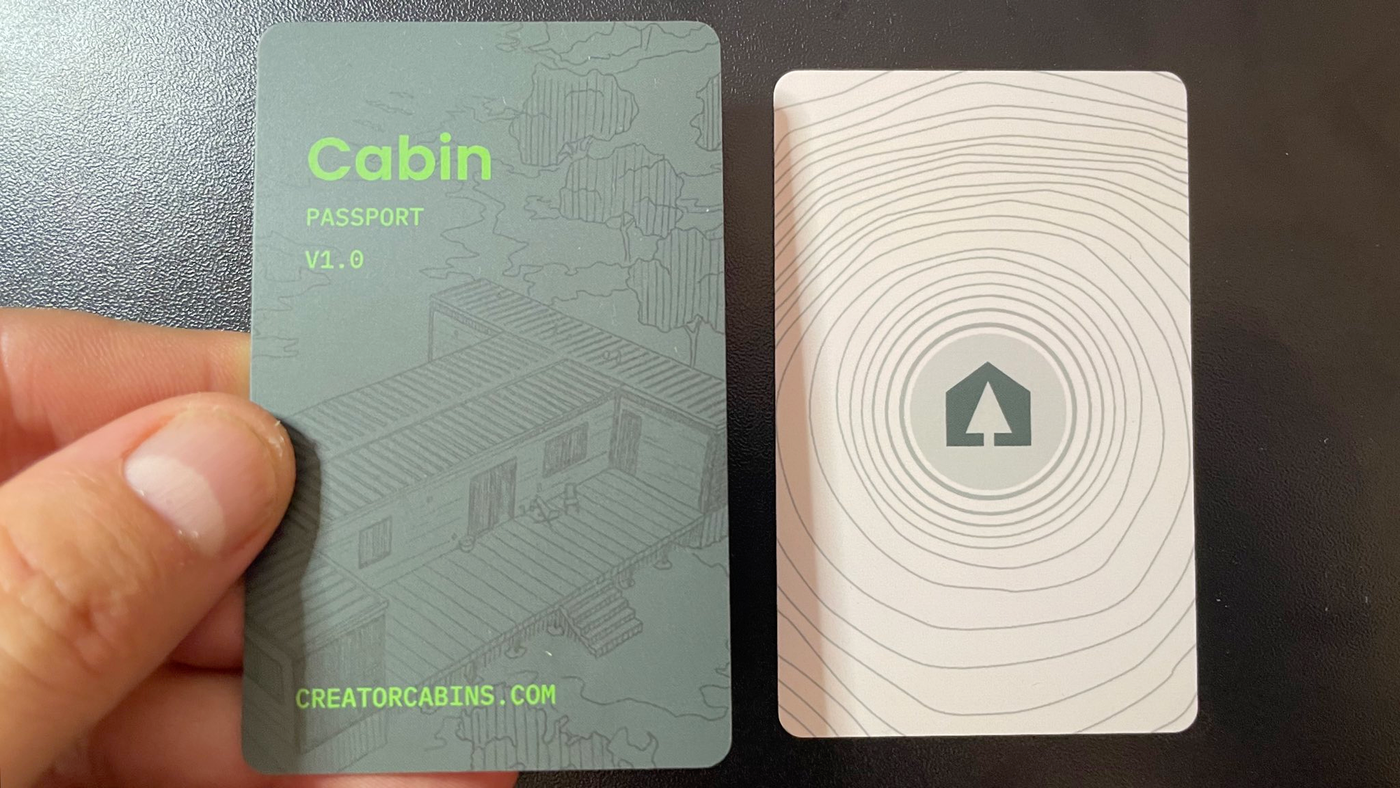
The "Physical Node Overview" and Cabin's resident "passes" together create a system that provides Cabin's "Cyber City" with verifiable trust, confirmation of ownership, and unification of the economic system. This system is special because it is autonomous, owned, operated and managed by the participants in the network. Value is given back directly to those who participate in the network.
The history of the network
Phase 0: Launch of DAO (2021-2022)
For the first year, we focused on a DAO Proof of Concept:
- "Physical Node 0" - our first physical node
- DAO-Oriented Check-ins and Retreats - Our First Residents
- Partner Members and Contributors - Our First Service Providers
- Pass and TCR - our first tool for physical nodes
- Media & Community - Our #1 Way to Connect Residents to Physical Nodes
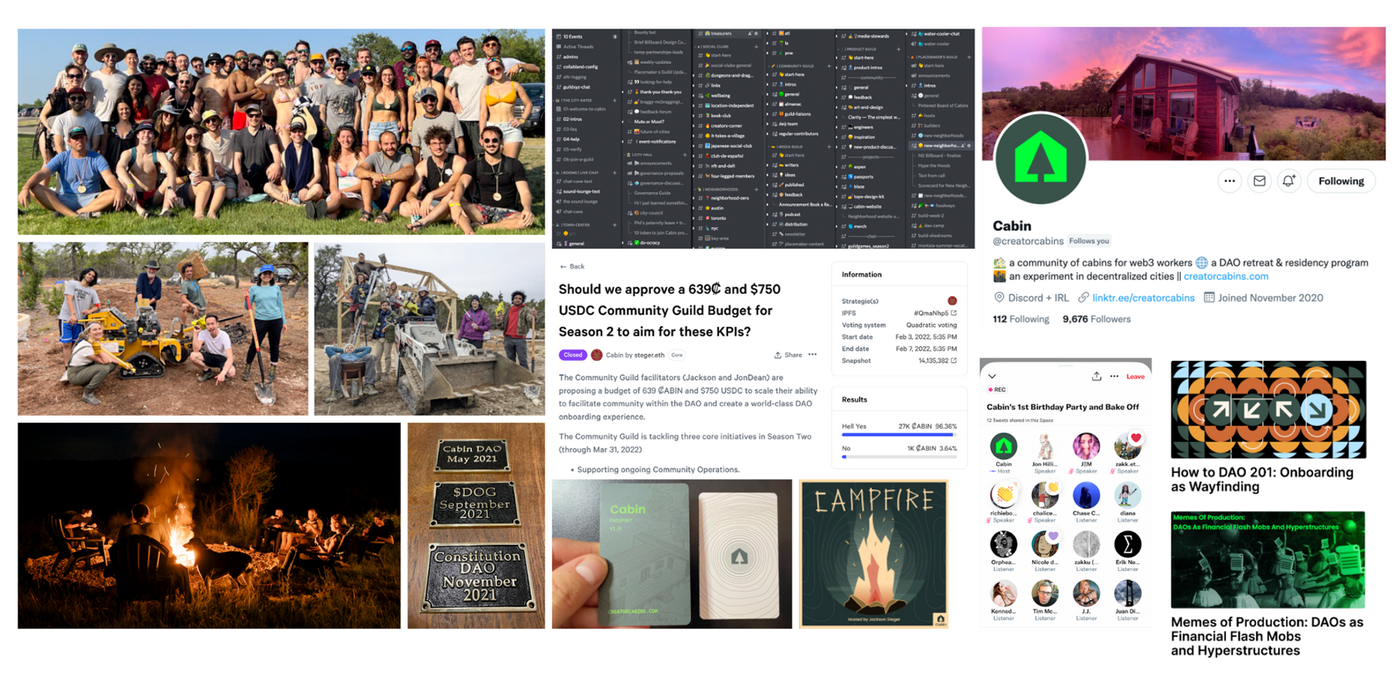
Now that these initial basic units are in place, and we have designed the basic mechanisms for their interaction in the network, Phase 0 has come to an end. Next, we are ready to start "seeding" the city.
Phase 1: Planting seeds for the "city" (2022-2023)
1 city | 10 physical nodes | 100 residents
With the addition of the first batch of new physical nodes, we have started Phase 1: Seeding the "city". At this stage, we will add the first batch of physical nodes to the network in a manually curated manner to ensure community quality, develop a good overview and define a good protocol. The main goals and milestones of this phase are:
- Manually add the first 10 physical nodes and build according to their needs
- Covering physical node retreats and residential needs (and attempting to provide long-term accommodation)
- Develop and test "Physical Node Overview" and its underlying protocol
- Development and proliferation of on-chain "vibe confirmation" and vouchers for residents via pass stamps
- Release more ₡ABIN to physical nodes and residents; currently ₡ABIN is still mainly held by the treasury
Phase 2: Grow the City Big (2023-2025)
1 city | 100 physical nodes | 1000 residents
Once we grow beyond 10 physical nodes, we will formally implement the Physical Node Profile protocol and use it to onboard new physical nodes. This will allow the physical nodes in our "network" to scale to a much larger scale. It also allows us the scale to add services to physical nodes, as well as good market liquidity to complement our offerings to residents. The main goals and milestones of this phase are:
- Onboard hundreds of physical nodes through our Physical Node Overview protocol
- Accommodate thousands of residents and provide long-term and flexible residency across physical nodes
- Develop new physical nodes from scratch through a network of physical node financing, property appraisal, community building, real estate development, insurance and other service providers
- Let a wider range of physical nodes, residents and contributors hold ₡ABIN
Phase 3: Building an Urban Alliance (2025-2525)
100 cities | 10,000 physical nodes | 1 million residents
When we reach the scale of 100 physical nodes and 1000 residents, the nature of the community will change again. The network itself will no longer look like a city. Swarms of physical nodes will spring up, their clusters more closely connected and loosely connected to the rest of the network. At this stage, it is conceivable that we will:
- Forked into a nested set of Physical Node Profiles running on a battle-proven protocol
- Established a permanent and solid node base all over the world
- Incorporates a broad economic system that provides goods and services for physical node development
- Empowering millions of people with a new way of living and working
You are done! We have also made a PDF version of this white paper, click here to download the file.
Introduction to ET Team
ET Squad, ETHEREUM TRANSLATION SQUAD. Together with other Chinese communities in Ethereum, we will better translate the English information in the Ethereum world into Chinese information. Using the decentralized social ideology represented by Ethereum, research attempts to establish a new form of social structure.
Like my work?
Don't forget to support or like, so I know you are with me..
Comment…